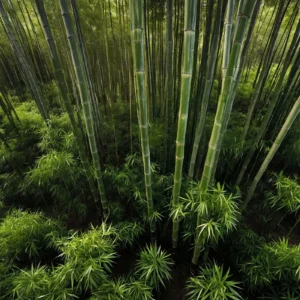In recent years, bamboo has gained significant attention as a sustainable alternative to traditional materials. From flooring and furniture to textiles and paper products, bamboo’s versatility and eco-friendliness make it an attractive choice for environmentally conscious consumers. This blog post will explore the environmental impact of bamboo and how choosing bamboo products can help combat climate change.
What is Bamboo?
Bamboo is a group of perennial evergreen plants in the grass family. Known for its rapid growth and remarkable strength, bamboo has been utilized for thousands of years in various cultures for construction, crafting, and even culinary purposes. Unlike traditional trees, bamboo can grow up to three feet in a single day, making it one of the fastest-growing plants on Earth.
Bamboo vs. Traditional Timber: Environmental Benefits
Rapid Growth and Harvest Cycle
One of the most significant environmental benefits of bamboo is its rapid growth rate. While hardwood trees can take decades to mature, bamboo can be harvested in just 3-5 years. This swift growth cycle means that bamboo can be produced more quickly and sustainably, reducing the strain on forests and decreasing the deforestation rates.
Carbon Sequestration
Bamboo is highly efficient at sequestering carbon dioxide from the atmosphere. During its growth, bamboo absorbs CO2 and releases 35% more oxygen compared to an equivalent stand of trees. This makes bamboo plantations an effective tool for mitigating climate change by reducing greenhouse gases in the atmosphere.
Soil Health and Erosion Control
Bamboo’s root system is robust and extensive, which helps in stabilizing the soil and preventing erosion. Unlike other crops that may degrade soil health over time, bamboo enriches the soil with nutrients and organic matter. This makes bamboo plantations beneficial for maintaining healthy ecosystems and preventing land degradation.
Minimal Pesticides and Fertilizers
Bamboo is naturally pest-resistant, which means it requires fewer pesticides compared to traditional crops. Additionally, bamboo can grow in a variety of soil types without the need for chemical fertilizers. This reduces the environmental impact associated with agricultural chemicals, which can contaminate water sources and harm wildlife.
Bamboo Products and Their Environmental Impact
Bamboo Flooring
Bamboo flooring is a popular alternative to hardwood flooring. It is not only durable and aesthetically pleasing but also environmentally friendly. The production of bamboo flooring has a lower carbon footprint compared to traditional hardwood, and its rapid renewability makes it a sustainable choice for homeowners looking to reduce their environmental impact.
Bamboo Textiles
Bamboo fibers are used to create a range of textile products, including clothing, towels, and bed linens. Bamboo textiles are praised for their softness, breathability, and antibacterial properties. The production process for bamboo textiles is less resource-intensive than conventional cotton, which requires significant amounts of water and pesticides.
Bamboo Paper Products
Bamboo paper products, such as toilet paper and napkins, are becoming increasingly popular as sustainable alternatives to traditional paper made from trees. Bamboo’s fast growth rate means it can be harvested more frequently, reducing the need for deforestation. Moreover, the production of bamboo paper typically involves fewer chemicals and less water compared to conventional paper production.
Bamboo Utensils and Kitchenware
Bamboo utensils, cutting boards, and other kitchenware are not only durable and stylish but also biodegradable. Unlike plastic, which can take hundreds of years to decompose, bamboo products break down naturally, reducing waste and pollution. By choosing bamboo kitchenware, consumers can help decrease the environmental impact associated with plastic waste.
The Role of Bamboo in Combating Climate Change
Carbon Footprint Reduction
Bamboo’s ability to sequester carbon dioxide makes it an essential tool in the fight against climate change. By incorporating more bamboo products into daily life, individuals can reduce their carbon footprint. For instance, using bamboo-based materials instead of plastic or wood can lower the demand for fossil fuels and decrease greenhouse gas emissions.
Sustainable Agriculture
Bamboo cultivation can contribute to more sustainable agricultural practices. Its resilience to pests and minimal need for fertilizers make it an eco-friendly crop that can be grown without depleting natural resources. This sustainable agriculture model can help feed a growing population while preserving the environment.
Habitat Preservation
Choosing bamboo products can also help preserve natural habitats. Traditional logging practices often lead to deforestation, which destroys the habitats of countless species. By reducing the demand for hardwood and opting for bamboo alternatives, we can protect forests and the biodiversity they support.
Challenges and Considerations
Sustainable Harvesting Practices
While bamboo is a highly sustainable resource, it is crucial to ensure that it is harvested responsibly. Over-harvesting can lead to soil erosion and loss of biodiversity. Consumers should look for bamboo products certified by organizations such as the Forest Stewardship Council (FSC) to ensure that the bamboo has been harvested sustainably.
Processing and Manufacturing
The environmental impact of bamboo products also depends on the processing and manufacturing methods used. Some processes, particularly for bamboo textiles, can involve harmful chemicals. It is essential to support manufacturers that use eco-friendly and non-toxic processing methods to minimize the environmental footprint of bamboo products.
Transportation and Carbon Emissions
Although bamboo has numerous environmental benefits, transporting bamboo products from their source to consumers can generate carbon emissions. To mitigate this, consumers should consider sourcing bamboo products locally when possible and supporting companies that use carbon-neutral shipping practices.
Conclusion: The Future of Bamboo in a Sustainable World
Bamboo’s numerous environmental benefits make it a promising resource in the fight against climate change. Its rapid growth, carbon sequestration capabilities, and versatility in various products offer a sustainable alternative to traditional materials. By choosing bamboo products, consumers can contribute to a more sustainable future and help combat climate change.
As awareness of bamboo’s environmental impact grows, it is essential to support sustainable harvesting and manufacturing practices. By making informed choices and supporting eco-friendly brands, we can maximize the positive impact of bamboo on the environment.
In conclusion, bamboo is more than just a trendy material; it is a vital resource in our quest for sustainability. By incorporating bamboo products into our lives, we can reduce our carbon footprint, preserve natural habitats, and promote sustainable agricultural practices. Together, we can harness the power of bamboo to create a greener, more sustainable world.





